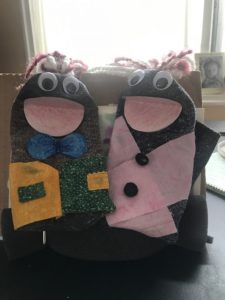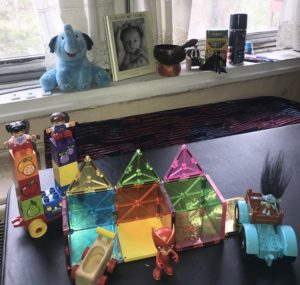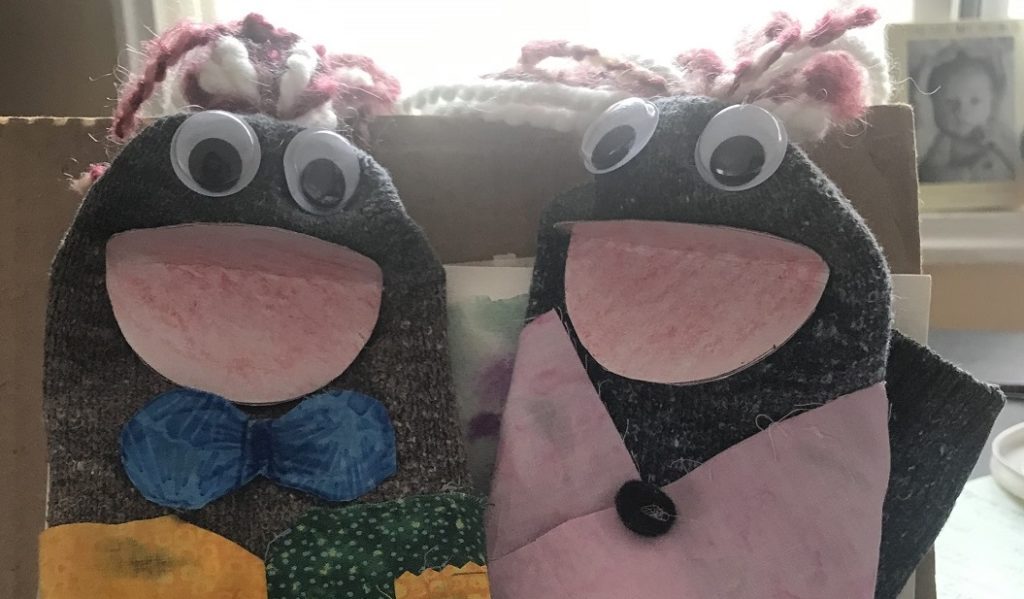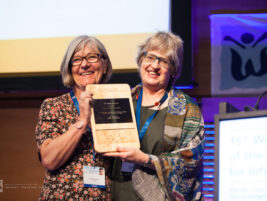The globe was impacted by a devastating virus.
Swiftly
This miniscule microorganism passed from soul to soul.
It entered our bodies.
It settled in our lungs, and we could not breathe.
It entered our minds making its way into the deep crevices of our brains reigniting our senses of fear.
Threatening our senses of
Safety.
Forcing us to rethink and reorganize our daily functions.
All the while, as infant mental health professionals,
keeping the baby in their family, in-sight.
As mental health professionals working dyadically one-on-one with families experiencing severe stress, and living in unfamiliar isolation, our team understood the need to maintain a sense of continuity and connection, and we jumped into action, creating a Telehealth model to serve as a vehicle that supports this sense of continuity.
The following is a vignette that illustrates the value of relationship, the importance of symbolic play, the need for flexibility, and the level of resilience in families.
Mary (Pseudonym) and Bobby (Pseudonym) (3 ½ years old)
Before the emergence of COVID-19, Mary began attending Chances for Children because she worried about her parenting, frequently asking herself, “Am I a good mother?” She also worried about her son’s ability to play with other children and his tendency to isolate himself. Bobby, who will be 4 in October, was timid and had a big imagination. During our initial sessions, Mary would chase Bobby. “Please, can I play with you? Please?” She would repeat this request, trying helplessly to push her way into Bobby’s imaginary world of super-heroes and dinosaurs. There was a perceived sense of desperation in Mary.
As our work together progressed, Mary began to understand her son’s need for an independent space to be creative. A very useful tool and intervention was Chances for Children’s use of video and video feedback. This protocol allowed Mary to observe herself and her son and to reflect on those shared moments.
There was a particular video which I will call “the shaving cream experience” that I believe helped move the therapeutic work. The play exercise required shaving cream to be scattered on a large tray, they were given paint brushes and small animal figures and mom and son were asked to paint the animals. They each picked up a brush, Mary asked Bobby, which animal should she pick. Bobby pointed to the dinosaur and they began to play. Sitting side-by-side, they exchanged stories about the dinosaur having a beard, or the bear having funny hair. They hummed silently yet in sync and they sang songs which sometimes Bobby initiated, and at other times, Mary initiated.
They tried to “paint” each other’s faces with the shaving cream and laughed. Bobby’s acceptance of mom, not as an intrusion but as a fun partner, was very clear in the video. During several video feedback sessions, Mary and I watched, processed, and reflected on their very gentle and enjoyable exchange. It can be concluded that Mary felt more confident in her skills as a mother and accepted by her son. And so, with the help of our video feedback and conversations, Mary began to approach Bobby’s world in a more gentle and introspective way.
Mary’s maternal conflicts stemmed from her relationship with her own mother whom she described as distant and uninvolved. As Mary slowly understood, acknowledged, and reflected about her own past, she began to gain confidence in herself as a different sort of parent, a parent who could co-create a different experience with her son.
Suddenly COVID 19 appeared and our working world was turned upside down. We introduced Telehealth as our new way of connecting.
From Face-to-Face Therapy to Telehealth
First session
Bobby was very curious the first time that we connected via WhatsApp. He ONLY wanted us to watch him play, and so we did. If he made a sound or a movement, as in making his car fly, we did the same, following his lead, and mirroring him. Reflecting on this, it seemed that Bobby was recreating the dynamic of our first session together, in which he insisted on playing alone, resisting any approach to join in or insert a separate thought. He seemed to have reverted to an earlier idea that relationships meant being overwhelmed and lost. It was as if he was asking, “Is this video thing safe? Do I have to start all over again from the beginning?”
During this first telehealth session I introduced Ralph, a homemade boy puppet. I did so for two reasons: one to offer a transitional character that was neither inanimate nor alive to reintroduce relationships, and second, because I hoped that Ralph could ease Bobby’s transition out of the session, often a difficult task for Bobby. Indeed, Ralph was most helpful!
Using a phone check midweek, Mary and I spoke about that first session. Mary was appreciative that we had connected and surprised at Bobby’s level of engagement.

Second session
I became more organized and structured about the sessions.
I began using body-based affect regulation and asked Mary and Bobby if they could scrunch up their faces really tight and then let go. I asked if they could make fists, squeeze them hard, and then let go. Then we breathed in and blew out our breaths together. They participated eagerly.
Then we started to play. Using Magnatiles, Bobby built an elaborate jail with robots trying to get out, a moving symbolization of his/our current circumstances as if we were in jail and wishing to get out. As the robots were trying to escape, the jail collapsed. Normally Bobby would be very upset and tantrum after working so hard on something and having it collapse, but this time, while he displayed minor upset, Mary was able to identify his emotional state and say: “It’s ok to be frustrated; we can build another one.” And they did.
Subsequent Sessions – Magnatiles became an integral part of our sessions as was Ralph. With great resilience, Bobby quickly accepted our video sessions as a safe way to continue to create stories, make meaning of our current situation, and continuing to build relationships.

In one session, Bobby built a castle with a moat filled with mud and, after a long story of dragons and fights, Ralph fell in the mud. Bobby and his mother “sent” an imaginary rope and tugged the rope to save Ralph. Together, we helped Bobby play out another scene of rescue which helped Bobby gain a much-needed sense of control. We celebrated Ralph’s rescue with a silly dance.
During another session where Ralph had not made his appearance yet, Bobby made pretend ice cream with Magnatiles and invited Ralph to share the ice cream with him. Ralph was called in, and I used my Magnatiles to create ice cream also. Bobby and Ralph shared chocolate ice cream with sprinkles, Mom and I joined in with our scoops. On another occasion again using Magnatiles, Bobby made a birthday cake, we sang happy birthday; he blew the candles, cut the cake, and we shared his chocolate cake.
Bobby and Mary remained at home as Bobby stated, “to hide from the virus”. They only ventured out to buy groceries or to go to the doctor. Bobby’s pre-school offered zoom class encounters every day at 11:00 am. The classes were brief, but they helped Bobby connect with his teacher and classmates.
Midweek Phone Check-In
An important part of this Telehealth intervention was the midweek phone check-in with Mary. During this time, Mary was able to freely share her fears about the virus, how her anxiety rose when Bobby became dysregulated, and how she tried to maintain a sense of calm. Many of our conversations also dealt with her own maternal conflict.
As already stated, Mary experienced her mother as distant and uninvolved. Mary was able to observe her own behavior with her son, which was involved, playful, and engaging, and reflect on her own relationship with her mother which was distant. Mary repeatedly stated that she appreciated our “adult” weekly conversations, as she called them.
I believe our sessions, both in person, and through Telehealth, allowed Mary to be heard and understood by another adult, providing her with a corrective experience. In the words of Selma Fraiberg et al. (1975), in their renowned article, Ghosts in the Nursery:
When the mother’s own cries are heard, she will hear her child’s cries” (Fraiberg et al., 1975).
This rang true for Mary and Bobby.
Having been heard and understood, helped Mary become more confident as a parent.
Mary was able to find exactly what she was searching for.
Mary had her experiences as a child with her mother, seen and heard.
Mary more and more began to experience a difference in herself as a mother to Bobby.
Bobby has let her in into his world.
Mary has learned to tolerate and understand that his “No!” is not a rejection of her, but a request for space and independence.
When Bobby needs her, he will call, and she will be there for him.
Mary felt accepted as Bobby’s mother.
Reflections and curious outcomes of Telehealth
Our Telehealth sessions bear a resemblance to in-person sessions in that they helped Bobby play out his fears, fantasies, and wishes. However, Bobby’s capacity to capture and accept the “remoteness” if you will, of our interactions, in addition to his ability to focus and feel a sense of connectedness via screen, was remarkable. While Mary, initially was much more apprehensive about being on screen, slowly she joined in, and supported Bobby’s variety of animated play stories.
A curious outcome of Telehealth in this particular situation was a freer sense of expression for Mary. During our in-person sessions, Mary seemed guarded and less forthcoming. However, Telehealth provided mom a shield of protection that allowed her to share more honestly and deeply, which brought with it a profound sense of introspection and change yielding a more attuned and confident parent.
The consistency of connection which Telehealth provided was critical for this dyad. When I scheduled our WhatsApp session at the same hour every week, I was there. Bobby knew that Ms. Martha was going to call, and we were going to connect to play. Mary reported that Bobby would plan what he wanted to play with and prepared what was needed. Just as I kept them in mind, Bobby and Mary were also keeping this encounter in mind. I do believe that having met the family and having had an established and ongoing relationship prior to COVID-19, made the transition to Telehealth easier.
“Virtual” experiences are no substitute for in-person experiences. However, I believe that Telehealth allowed Bobby to practice essential developmental skills. Waiting and taking turns, for example, were constantly in play. While Bobby had difficulty tolerating others initiating play, slowly, Bobby began to accept his mom’s, Ralph’s, and my needs, to build a Lego tower at a slower pace, for example, or to take turns adding magnatiles to a castle. It was constantly repeated “it’s mommy’s turn”, “its Bobby’s turn” “It’s Ms. Martha’s turn”, etc. One time, I made Ralph jump the turn, and Bobby said: “it’s not your turn Ralph”. Bobby then began to internalize this experience and accept it as a norm.
Another curious outcome of our Telehealth sessions was Mary’s level of attunement to her son’s play themes. A note, our Telehealth sessions were on WhatsApp, we used our phone screen, which was pretty small, and many times I couldn’t see all the action. I would ask Mary and she would narrate what was happening, which included action and feelings. This allowed Bobby to hear mom’s interpretation of the “story”. Bobby would look at mommy and listen intently to her narration, he then would nod in agreement, and continue playing, or disagree with her and mom would correct the narrative. Bobby felt understood by her. This very subtle exchange in this parent-child relationship, helped to strengthen their bond.
Final Reflections
While COVID-19 turned all our worlds upside down, as a clinician, I made adjustments to how I practiced. Tweaking light, sound, backgrounds, ordering toys, and making puppets in order to support this new virtual therapeutic experience became important. Along with, expecting the unexpected, such as, a very-young child’s capacity to focus, and understanding a child might only be on screen for 5 minutes, it’s okay. As with home visiting programs, being sensitive to and respecting our family’s homes, personal space, style, and circumstances. Being cognizant of privacy or the lack of. All this became part of this new way of practicing.
During the COVID-19 quarantine, young children do not have the ability to connect physically with other children. How can all the Bobby’s and Lucy’s try out their skills of waiting and taking turns, of leading and following, of managing transitions, of separating from mommy, finding her reliably there at the end of the day and saying “Hello!”? It is likely that a backlash of our sheltering-in-place will be that very-young children will have to relearn these important experiences and skills.
I believe that our Telehealth sessions helped to sustain our therapeutic work. There was much progress in Bobby and Mary. Bobby included us in his play, he began to tolerate waiting, he began to label feelings, he began to tolerate and focus during his zoom school classes. Mary reflected on her behavior and felt proud about how responsive and less intrusive she had become.
Reference
Fraiberg, S., Adelson, E., & Shapiro, V. (1975). Ghosts in the nursery: A psychoanalytic approach to the problem of impaired infant–mother relationships. Journal of the American Academy of Child Psychiatry, 14, 387– 421.
Authors
Alvarez, Martha,
LCSW, Chances for Children (CFC) Bronx, New York, USA








